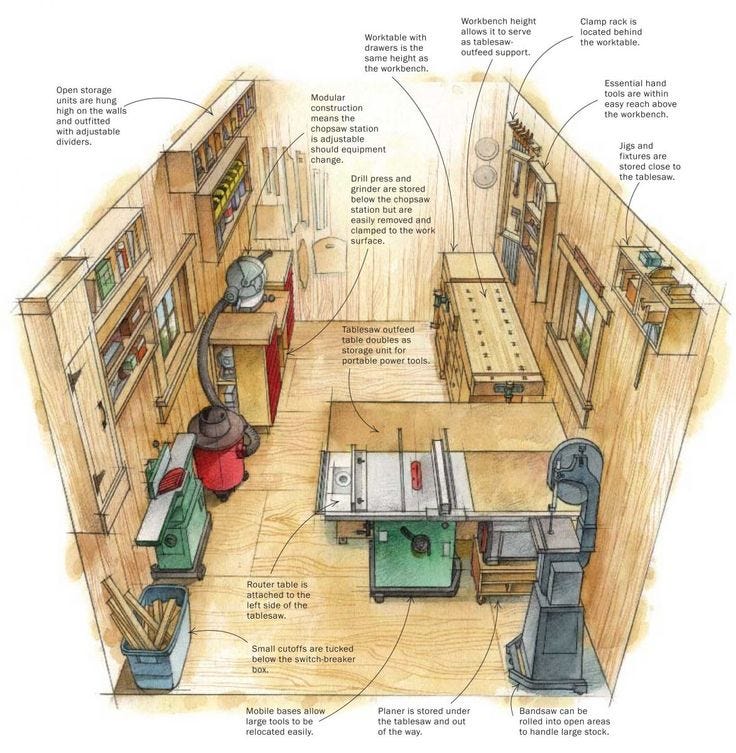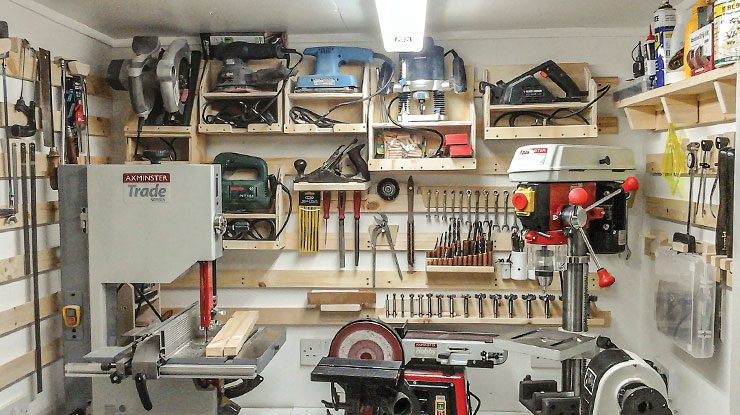A woodworking shop size varies based on needs, but a good starting point is around 400 square feet. When setting up your shop, consider space for tools, workbenches, and storage.
Having ample space allows for efficient workflow and better organization. It’s essential to plan the layout carefully to maximize productivity and safety in your woodworking shop. Proper ventilation, lighting, and access to power outlets are also key factors to consider when determining the size of your woodworking shop.
By creating a well-designed space, you can enhance your woodworking experience and create a functional and comfortable environment for your craft.

Credit: community.furnitology.com
The Ideal Dimensions For A Woodworking Shop
An ideal woodworking shop should be spacious enough to accommodate tools and workstations comfortably. A recommended size would be around 400-600 square feet, allowing ample space for maneuvering and storage of materials and equipment. This size ensures efficiency and functionality in a woodworking environment.
When it comes to woodworking, having a properly sized workshop is crucial to ensure a comfortable and efficient work environment. The size of your woodworking shop will depend on many factors, including the type of projects you plan to work on, the amount of space you have available, and your personal preferences. Here are some guidelines for the ideal dimensions for a woodworking shop:Space For Machinery
One of the most important considerations when it comes to the size of your woodworking shop is the space you need for your machinery. Your shop should be large enough to accommodate all of your tools and equipment, including table saws, jointers, planers, and other large machines. As a general rule, you should have at least 25 square feet of space per machine, although this may vary depending on the size of your equipment.Room For Materials Storage
In addition to space for your machinery, you’ll also need ample room for materials storage. This includes lumber, sheet goods, and other supplies. Ideally, you should have enough space to store all of your materials in an organized and accessible way. As a general rule, you should plan for at least 100 square feet of storage space for every 500 square feet of workshop area.Workspace For You
Of course, you’ll also need space to work on your projects. This includes a workbench, assembly table, and other workspace areas. In general, you should plan for at least 100 square feet of workspace for every 500 square feet of workshop area.Lighting And Ventilation
Finally, it’s important to consider lighting and ventilation when planning the size of your woodworking shop. You’ll need adequate lighting to ensure that you can see what you’re doing, and proper ventilation to prevent dust and fumes from building up in your workspace. As a general rule, you should plan for at least 50 lumens per square foot of workspace, and at least one air exchange per hour. In conclusion, the ideal dimensions for a woodworking shop will depend on many factors, including the type of projects you plan to work on, the amount of space you have available, and your personal preferences. By considering the space you need for machinery, materials storage, workspace, lighting, and ventilation, you can create a comfortable and efficient woodworking shop that meets your needs.
Credit: medium.com
Evaluating Your Woodworking Projects
Before setting up your woodworking shop, it’s important to evaluate the type of projects you plan to undertake. This will help determine the appropriate size for your workshop. Consider the following factors:
Type Of Projects
The type of projects you typically work on will greatly influence the size of your woodworking shop. Are you mostly focused on small-scale projects like jewelry boxes and cutting boards? Or do you tackle larger, more intricate pieces like cabinets and furniture? Understanding the scale and complexity of your projects will guide you in determining the space requirements for your workshop.
Scale And Complexity
The scale and complexity of your woodworking projects are crucial considerations when deciding on the size of your workshop. Larger projects require more space for maneuvering and assembly, while intricate designs may necessitate additional workstations or specialized equipment. Additionally, consider if you will be working on multiple projects simultaneously, as this will impact the space needed to accommodate multiple workstations or assembly areas.
To evaluate the scale and complexity of your projects, ask yourself:
- What is the average size of my projects?
- Do I need space for large machinery or equipment?
- Will I be working on multiple projects at once?
- Do I require a dedicated area for assembly or finishing?
By assessing these aspects of your woodworking projects, you can determine the ideal size for your woodworking shop. Remember, it’s essential to have enough space to comfortably work on your projects while ensuring efficient workflow and safety.
Essential Tools And Their Space Requirements
When planning the size of your woodworking shop, it’s crucial to consider the space requirements of essential tools. The right amount of space for your major power tools, hand tools, and workbenches will ensure a functional and efficient workspace. Let’s delve into the space requirements of each category of tools.
Major Power Tools
Major power tools such as table saws, band saws, and jointers require significant space for safe operation and maneuverability. Here’s a quick overview of the space requirements for some common major power tools:
| Power Tool | Space Requirement |
|---|---|
| Table Saw | At least 25 square feet for a contractor saw, and 50 square feet for a cabinet saw |
| Band Saw | Around 20 square feet for a standard-sized band saw |
| Jointer | Approximately 20 square feet for a 6-inch jointer, and 30 square feet for an 8-inch jointer |
Hand Tools And Workbenches
Hand tools and workbenches are essential components of any woodworking shop and require adequate space for storage and usage. Consider the following space requirements for hand tools and workbenches:
- Hand Tool Storage: Allocate space for a tool cabinet or wall-mounted tool storage to keep your hand tools organized and easily accessible.
- Workbench Area: A dedicated workbench area of at least 6 feet by 3 feet provides ample space for various woodworking tasks.
- Bench-Top Tools: If you plan to incorporate bench-top tools such as a drill press or spindle sander, ensure sufficient space for their operation and storage.
Workspace Layout Considerations
When planning the layout of a woodworking shop, it’s crucial to consider the space needed for efficient operations. The size of the shop should allow for ample room to maneuver large tools and work on projects comfortably. A spacious layout ensures safety and optimal workflow for woodworking activities.
When setting up a woodworking shop, one of the most crucial aspects to consider is the workspace layout. An efficient and well-organized layout can greatly enhance productivity, workflow efficiency, and safety in the shop. In this section, we will explore two key factors to consider when planning your woodworking shop’s workspace layout: Workflow Efficiency and Safety and Mobility.
Workflow Efficiency
Creating a workflow that allows for smooth and efficient movement throughout the woodworking shop is essential for maximizing productivity. Consider the following tips to optimize workflow efficiency:
- Arrange workstations strategically: Position workstations in a logical order, ensuring that tools, equipment, and materials are easily accessible. This helps minimize unnecessary movement and saves time.
- Group related tasks: Cluster similar woodworking processes and tasks together. For example, keep the cutting and shaping tools near the workbench to avoid unnecessary trips across the shop.
- Plan for adequate space: Ensure that each workstation has enough space for the craftsman to move freely and comfortably. This prevents clutter and minimizes the risk of accidents.
- Consider workflow direction: Arrange the layout so that the workflow follows a logical progression, from raw materials to finished products. This helps streamline the woodworking process and reduces wasted time and effort.
Safety And Mobility
Creating a safe and mobile woodworking shop layout is crucial to ensure the well-being of the craftsman and the longevity of the equipment. Here are some important considerations for safety and mobility:
- Clear and unobstructed pathways: Keep the pathways free from clutter, tools, and materials to prevent tripping hazards and allow for easy movement.
- Proper storage and organization: Implement a systematic storage system for tools and materials to keep the workspace tidy and minimize the risk of accidents caused by loose objects.
- Well-lit workspace: Ensure that the woodworking shop has adequate lighting to minimize the risk of accidents and facilitate precision work.
- Consider mobility: If possible, invest in mobile workstations or tools that can be easily moved around the shop. This allows for flexibility in rearranging the layout and adapting to different project requirements.
- Emergency exits and safety equipment: Plan for emergency exits and have essential safety equipment, such as fire extinguishers and first aid kits, easily accessible in case of emergencies.
The Impact Of Ceiling Height In Woodworking Shops
The Impact of Ceiling Height in Woodworking Shops
In woodworking shops, the ceiling height plays a crucial role in creating a functional and efficient workspace. The vertical space in a shop directly impacts the type of equipment that can be used, the storage solutions that can be implemented, and the overall comfort and safety of the space. Let’s explore how ceiling height influences key aspects of woodworking shop design.
Storage Solutions
When designing a woodworking shop, the ceiling height directly affects the type and layout of storage solutions that can be utilized. Tall ceilings allow for the installation of overhead racks and shelving, maximizing storage capacity without encroaching on valuable floor space. Additionally, the ability to store materials and tools vertically reduces clutter and enhances organization, leading to a more efficient and productive workspace.
Dust Collection Systems
The installation of effective dust collection systems is paramount in woodworking shops to maintain a clean and healthy environment. Ample ceiling height facilitates the implementation of overhead ductwork, ensuring efficient capture and removal of sawdust and debris. With sufficient clearance, the ducting can be strategically positioned to optimize airflow and minimize obstructions, enhancing the overall effectiveness of the dust collection system.

Credit: www.amazon.com
Balancing Shop Size With Budget Constraints
When setting up a woodworking shop, it’s crucial to balance shop size with budget constraints. By optimizing your shop size, you can maximize efficiency without overspending. Here’s how to achieve this:
Cost-effective Design
Create a cost-effective layout that maximizes space utilization.
Opt for multi-functional tools to save space and money.
Maximizing Your Investment
Invest in quality tools and equipment for long-term savings.
Consider expandability for future growth and flexibility.
Expandability And Future-proofing Your Shop
When designing a woodworking shop, it’s crucial to consider its expandability and future-proofing. This involves creating a space that can adapt and grow as your needs evolve over time.
Modular Design
A modular design allows you to easily rearrange and reconfigure your shop layout as needed. This flexibility ensures that your workspace can accommodate new tools and equipment without major renovations.
Scalable Equipment
Investing in scalable equipment means choosing tools and machinery that can be upgraded or expanded in the future. This approach saves you from having to replace entire systems as your woodworking projects become more complex.
Real-life Examples Of Efficient Woodworking Shops
Efficient woodworking shops come in various sizes, depending on the specific needs of the woodworker. Some real-life examples of well-designed woodworking shops range from small, compact spaces that maximize organization to larger, spacious workshops that allow for larger projects and machinery.
The key is to create a layout that optimizes workflow and provides ample space for tools, materials, and workstations.
Small-scale Success Stories
Small workshops can be highly efficient with smart organization.
Maximize space with wall-mounted storage for tools.
Utilize multi-functional equipment for versatility.
Large Workshop Tours
Spacious layouts in large shops allow room for creativity.
Invest in quality dust collection systems for cleanliness.
Ergonomic design enhances workflow efficiency.
Frequently Asked Questions
What Factors Should I Consider When Determining The Size Of My Woodworking Shop?
When determining the size of your woodworking shop, consider the space needed for tools, workbenches, and material storage. Also, factor in space for movement and future expansion to accommodate larger projects.
How Can Shop Layout Affect The Size Of A Woodworking Shop?
Efficient shop layout can maximize space utilization, potentially allowing a smaller shop to be more functional. Considerations such as tool placement, workflow efficiency, and storage solutions can all impact the overall size requirements.
What Are Some Space-saving Tips For A Small Woodworking Shop?
Utilize wall-mounted storage, multifunctional workstations, and compact tool designs to optimize space. Additionally, thoughtful organization and regular decluttering can help maintain a functional workspace in a smaller area.
How Can A Larger Woodworking Shop Provide Advantages?
A larger woodworking shop can offer increased flexibility for larger projects, more spacious work areas, and the ability to accommodate additional tools and equipment. It may also allow for a dedicated finishing area and separate zones for different woodworking processes.
Conclusion
After considering the factors of space, budget, and intended projects, it’s clear that there’s no one-size-fits-all answer to the question of how big a woodworking shop should be. Ultimately, it comes down to personal preference and goals. However, it’s important to remember that a well-organized and functional shop can increase productivity and enjoyment of the craft.
By carefully evaluating needs and resources, woodworkers can create a shop that suits their needs and allows them to create beautiful and functional pieces for years to come.



